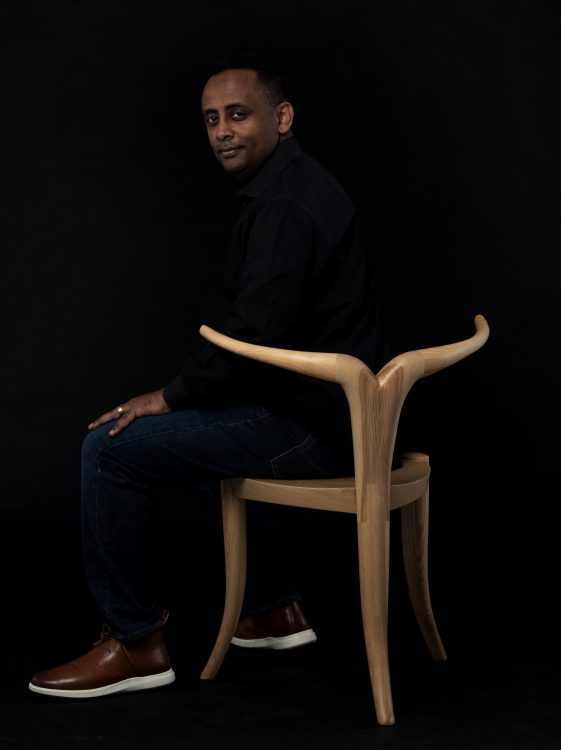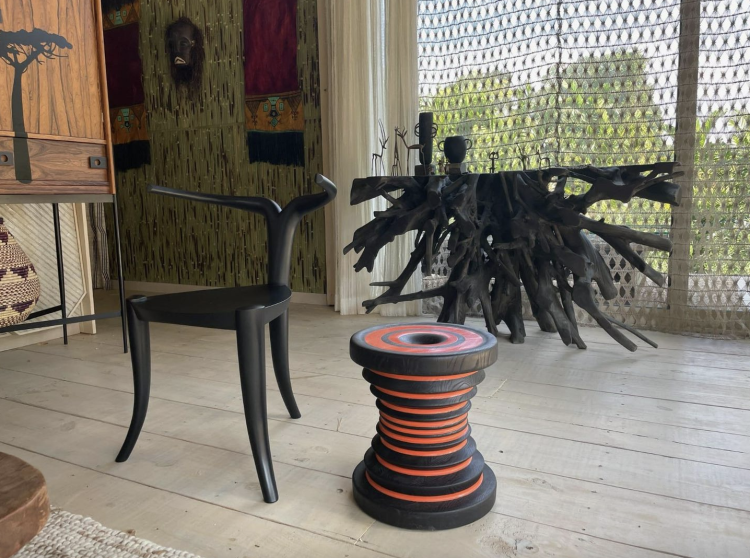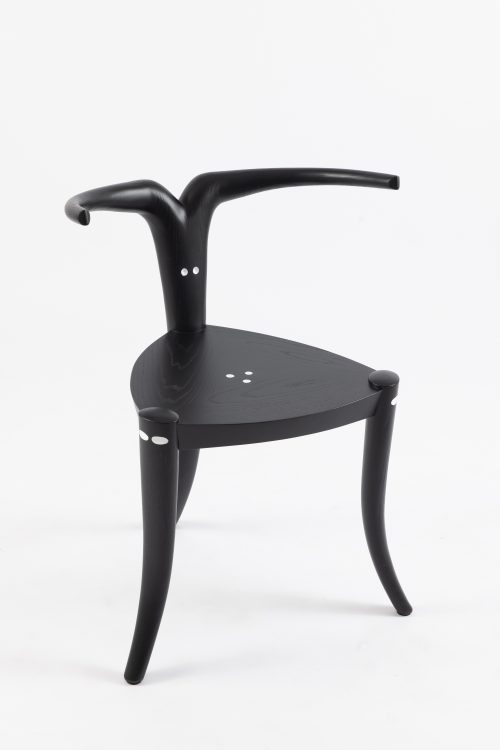Welcome to Artisan Spotlight, a column where we highlight Members’ favorite crafts and tradespeople, showing the work they bring to finished projects as well as the ways they view craftsmanship in a digitized world.

Jomo Tariku in his Nyala chair. Photo: Gediyion Kifle
When Jomo Tariku set about designing a new type of modern African furniture some 30 years ago, he set on a path to do much more than produce handmade chairs. Gaining recognition for his furniture (which is now in the permanent collection of nine museums) has gone hand-in-hand with rethinking the entire canon of design history—and reshaping the definition of collectible furniture today.
Jomo’s first foray into furniture came through the research library at The University of Kansas, where the Ethiopian-born creative began diving into design history. His research revealed two things: One, there was a severe dearth of Black creativity represented in the central design canon and two: What records there were of African design tended to revolve around tired tropes of tribal design. The concept of modern, collectible furniture and the rich history of African design seemed to be existing on two different spheres. It became Jomo’s goal to change that, primarily through his work—sculptural, handmade seats that are essentially pieces of functional art—but also through his approach to business—refining a production method that could work both stateside and in his home country—and, perhaps most of all, through his activism. Jomo is an active member of BADG, the Black Artists + Designers Guild, a network of Black creatives founded in 2018 to address a lack of representation in the design industry. He sees the group poised to answer an imporatnt question: What could more inclusive collecting look like? Here, we caught up with the Virginia-based creative on his process, challenges, and vision for the future of craft.
This conversation had been edited for length and clarity.
Tell us a little bit about how you got started in your field.
My work is totally, or mostly, focused on my own African heritage. That’s a launchpad to designing home furnishings. It’s mostly seating for the moment; I’ve done one table. I find seats challenging to come up with a new idea and they’re something I can design that’s small enough to keep in a warehouse and ship. As a small business owner who pretty much operates out of my own single car garage, it is something that I’ve preferred to do.
The way I got into this was I was doing my Masters in Design thesis in college and I wanted to do something I could take back home if I ended up going back home, and actually scale up and produce, so I didn’t want to do projects based, for example, on electronics—things that a single person in Ethiopia couldn’t produce. I didn’t want the idea to die when I left school.
As a student going through the architecture and design library at The University of Kansas, i always noticed any Black designers and their work in any books or magazines. I said, “There is a problem to solve here.” There doesn’t seem to be exposure to a lot of modern African design, so I can focus on that. That was in 1993, so it’s been a 30 year journey.
As you say, your work is deeply rooted in African history but is decidedly modern; can you talk more about that dichotomy?
I always want to credit the things that influence me from the continent of Africa. This is the contradiction I always deal with: Even though I grew up in Ethiopia, I went to college here, and learned how modern day designers in the US function, while I was also aware of how traditional craftspeople in Africa operate, which is creating items anonymously. There is no branding exercise. To brand using a designer’s name, licensing–these do not happen there. Craftspeople there create beautiful items and what excites me about their approach is these objects they create have duality. I use the traditional Ethiopian coffee pot as an example: It’s useful, you brew coffee with it, but once it’s done, you put it on the mantel to decorate. That’s how I approach my design; I want it to be beautiful but functional at the same time. I don’t want sculptural pieces that you’re afraid to sit on, but if you’re not sitting on them I want them to be a beautiful artistic statement for the owners.
And then where I step away from the artistic and go into my engineering mind is that my chairs are ergonomic, they are comfortable, I worry about how we can produce them more sustainably and efficiently. We are always trying to use less materials and to reduce costs—especially when wood fluctuates so much in cost and has gone up so much. I am material agnostic but I do use wood more because I can’t have all types of materials in my shop—I just don’t have the space. It’s not that I don’t want to use metal, it’s just not manageable.
It’s been a 30 year journey and suddenly things are happening–I want to take advantage of everything that comes my way.
Tell us a bit more about how you work with other craftspeople.
I have a fantastic chair maker out of Columbia, VA, David, who does some of the chairs, and I have another David in Richmond working on anything related to wood turning. I mostly go to them for finishing, which I used to do in my shop but have now outsourced, so we use a great woman-owned company. The process is mostly I take my CAD drawings—and as of late I’ve been using a 3D printer for scaled versions of my designs—and produce a quick mockup to check ergonomics and the 3D look of it, then we go to the full version of the chair design. All of these are handmade, especially the Nyala chair, which is hand-carved. That’s what makes them expensive, but also unique. And we have started making a signature line for Wexler Gallery so they’ve managed to sell a few of these at a higher price. Right now my business model is fluctuating between a gallery model and the chairs I produce in my own shop of with artisan partners. I’m working on a model that could be licensed out of a manufacturer in North Carolina.
I love the mix of it—I don’t want to be constrained. A lot of people think “If you do gallery you can’t do the rest”—I say, “why not?” I want to do both. My chairs are carried by the MoMA Design Store but also a gallery. It’s been a 30 year journey and suddenly things are happening–I want to take advantage of everything that comes my way.

Some of Jomo’s furniture on the set of Black Panther: Wakanda Forever. Photo: Marvel.
How do you come up with unique strategies for these different models?
Well it’s all different. With the gallery, the advantage is that they know the artistic value of the item. As an industrial designer, that has been a learning process for me, of what these unique designs should be valued at. As a businessman you can say, if I sell something three times the cost of production I should be fine, but because of their uniqueness they have an intrinsic value. I’ve always thought that but I just didn’t think people would pay it. The gallery also is able to educate the collectors, which is so important.
How did you find your collaborators?
It was very difficult to find them and it is maybe a sign of the industry; I don’t know if it’s improving or not. That part worries me because there are more designers like me who need to get their designs fabricated by experts like mine. If it took me this long to find—and I Googled, went to events, reached out to tons—I think there are not that many. Most fabricators you find are doing cabinetry or tables; chairs are complicated.
How do you work with interior designers?
I love working with designers. I think the biggest challenge is being asked if I have pricing for the industry; I’m a small operator and I fund all these projects myself. I know people see an expensive chair on my website but the margins are thin. And it’s not easy going through three, four prototypes. The way I recover that is by launching my products, so a discounting model doesn’t work. But I love working with them, and right now I am gearing up to work with more. Right now everything is made to order but we are trying to see if we can tweak that a bit and have some items made ahead of time so we can ship to designers as soon as they order.
What you’re doing as a museum when you buy a Black artist’s work is you are making the industry more robust—and more realistic.
You’re now represented in a few museums; what’s the significance of that to you?
It has multiple significances. First, I am a lover of museums; whenever friends visit I want to take them to museums. But just like my library experience when I was doing my thesis and not seeing works represented from the continent of Africa or Black designers, it’s been a curious trip for me. Yes, I enjoy learning about other famous designers or artists, but at the end of the day, people like me were missing from the canon; that’s a big thing I want changed. And that’s something I keep working on—we met through the [Black Artists and Designers] Guild, and that’s such a part of what that organization does.
What you’re doing as a museum when you buy a Black artist’s work is you are making the industry more robust—and more realistic. You know the saying that design is a global language; well, if there aren’t Black people in it, it’s not global! So if you want to be representative, this is it. The first institution that reached out to me to acquire my work was The Met, and I thought it wasn’t real; I had to verify that she wanted it for the museum and not just a personal purchase. So The Met being the first one was incredible. They ended up commissioning a concept chair that I had for awhile and couldn’t afford to make, and that was a wonderful experience. Seeing my work acquired—I think it’s officially now nine museums, and all of them are prominent museums—it’s a big deal.
It’s a matter of changing the topic of collection. That will be a topic at our forum at Design/Miami this year.

The Nyala chair in black. Photo: Julia Lehman photography.
What role do you play for your collectors?
I’m kind of an—I don’t want to say the world but—an evangelist on this topic. Because after a 30 year journey, it’s still fresh why it took this long. When the topic of a lack of Black work in museums or shows comes up, people love to say “It should be about merit.” So then what are you saying about my work? I personally know my work is not crap, so I want to demystify the idea that all the accolades, promotion, gallery representation is about merit. I have a hard time accepting this argument. It is more than that—it’s who you know, the social circle. Most Black designers don’t have access to that—to the market, to galleries; I had never met a gallerist before working with one. Wexler was the first who had a face to face with me.
That’s why, whenever I am invited to speaking engagements, anywhere I have a chance to meet industry people or curators, I always thank them for buying my work, but also say “Please know there are many more. I don’t want to be a token—go out and check out more work. There are so many; if you want I will give you a list!” That was the reason behind that New York Times article we did with the Guild, was just to show the range of what Black creatives are making. It’s not just one thing.
There was a trend maybe 10 or 15 years ago, whenever a Black designer was mentioned, the focus became “is it upcycled?” And yeah, we do upcycled stuff, but we do modern stuff too. Don’t pigeonhole us. I also want to demystify that there aren’t buyers for our work. What we need is various expressions for our work to be out there to reach those buyers.
For me, this advocacy is what will give us staying power. If it becomes focused on one designer’s achievement, it won’t last.
What’s next for you?
My biggest challenge is in scaling up, and I often have to step away from big opportunities because I’m not big enough. That’s why I want to build my own shop. I know I cannot handle all these projects in the future, but I’ve gotten queries in the hospitality industry which would mean high volume production. I need to find that sweet spot that works. The plan is to make my own shop where, if we want to make one or two designs, fine, but if we want to do 20, we’re capable of that, too.
As for Design Miami, I will launch some new designs. I’ll be stepping away from chairs and launching a large cabinet, a bench, and a bronze chair with Wexler Gallery. So different materials and different products.